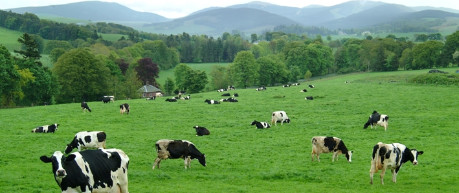Wednesday 10th February 2021, 5:00pm
A tool to help farmers make better decisions about what to feed their livestock has generated a wealth of open-access data.

You are what you eat, as the old adage goes, also applies to livestock. An animalís feed closely determines its health, and its ability to produce high-quality milk, meat or eggs.
By the same logic, better animal products provide better nutrition to people, and more income to livestock-keepers. Farmers, extension workers, researchers and policymakers working on livestock need a good understanding of animal feeds.
Now a tool makes it possible to visually explore standardised data on what livestock eat in low-and middle-income countries.
The data behind the visualisation was generated using the Feed Assessment Tool (FEAST), and is the product of thousands of data uploads from more than 150 sites in 14 countries. Researchers at the Global Academy of Agriculture and Food Security and the International Livestock Research Institute (ILRI) helped initiate the development of the FEAST Tool, which helps users assess overall availability of feeds, the quality, and the seasonality in a particular site.
Users collect the data in a standardised format, and are encouraged to submit their results to the open access FEAST Global Data repository, launched in 2016.
"There is a real dearth of data as to what livestock are fed. This tool was originally developed to help farmers, but it has generated a wealth of farmer-based data that we felt was useful for a wider community."
Professor Alan Duncan, Global Academy for Agriculture and Food Security, and International Livestock Research Institute (ILRI)Researchers worked with members of the Livestock Data for Decisions (LD4D) community to visualise the data. Users can explore how overall feed availability changes month by month or season by season in a particular site, see how feed sources change depending on the season, and explore how different sources of feed contribute to animal diets over the course of a year.
The data visualisation offers new insights for decision makers. For example, the climate change modelling community needs to understand what livestock are fed in order to calculate emissions from the sector.
"While the FEAST tool helps identify possible improvements in a particular site, the rich body of FEAST data offers insights on overall trends, gaps and opportunities."
Professor Alan Duncan, Global Academy for Agriculture and Food Security, and International Livestock Research Institute (ILRI)This kind of data could also be used to develop a better understanding of planted forages, and what different forages are used in different countries.
"Sound feed-related data are a requisite for formulation of good policies for sustainable livestock development."
Harinder Makkar, International Development Expert in Sustainable Livestock ProductionThe FEAST tool and the global data repository are available to anyone working on livestock feeds, and to anyone more generally interested in understanding the livestock sector in low-and middle-income countries. The data is free to use, and contributions from users are welcomed.